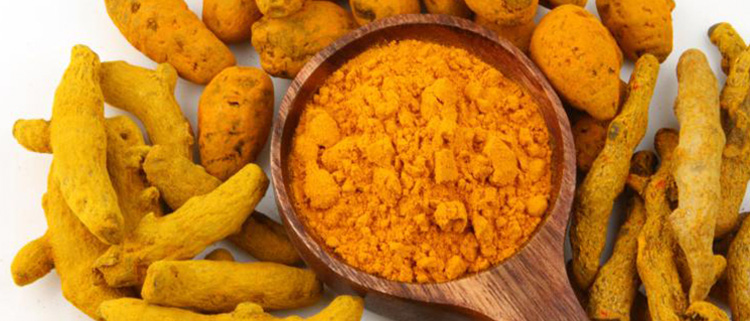https://cdn.steemitimages.com/DQmTmGFLk6MMp9mQFKSygcxnPK9ga7Ewa87MANi6k4tVnvs/curcuma-polvo-piel.jpg
[source](https://laguiadelasvitaminas.com/wp-content/uploads/2018/04/curcuma-polvo-piel.jpg)

The genus Curcuma belongs to the Zingiberaceae family and includes 80 known species, among which the most used in nutrition and phytotherapy is Curcuma longa. While the taste is very volatile, on the contrary, the color does not change over time. For this reason, turmeric is a substance that is widely used in the food industry as a dye for many foods such as cheese, yogurt, mustard, various canned broths and other products that are often stained with turmeric derivatives. The perennial herbaceous plant, which reaches a maximum height of approximately 1 m. In the cultivated state, turmeric is present in many tropical or subtropical areas. The leaves are large, 20 to 45 cm long, with an elongated petiole. The flowers are collected in a colorful pseudo-inflorescence rich in large green bracts at the bottom and white or purple at the top. The green bracts form a series of pockets, which house large yellow flowers (with possible orange tones). The root is a large cylindrical rhizome, branched, yellow or orange, strongly aromatic, which is the most used part of the plant. From a food point of view, turmeric powder is very common in Western cuisine, one of the quintessential symbols of healthy and natural nutrition. This powder, which is bright yellow and has a very intense flavor, has many anti-inflammatory, immunostimulant and antioxidant properties. Its rhizome, in fact, fights chronic inflammatory diseases that affect the intestine and joints and rebalances the digestive system by detoxifying the stomach, liver and intestines in depth. Curcumin, the active ingredient in this spice and responsible for its color, is a fantastic antioxidant that seems to improve insulin resistance: that is why it is often recommended in case of diabetes, glucose intolerance, metabolic syndrome or presence of high levels of sugars, triglycerides and cholesterol in the blood. In addition, we do not forget that curcumin counteracts depression because it increases the levels of serotonin and dopamine, the two neurotransmitters that regulate mood. Curcuma is recognized as a protective immune system, since it is a powerful antioxidant capable of counteracting the action of free radicals, responsible for the aging process and the damage to the membranes of the cells that make up our body. Its antibacterial and anti-inflammatory action makes it useful for gastritis, heartburn, cystitis and candidiasis. Curcuma rhizome is applied to the skin to treat wounds, burns, insect bites and skin diseases with really satisfactory results. Turmeric is also useful in cases of loss of appetite, so much that it is indicated during convalescence, when the body needs to recover. Turmeric is perfect against inflammations of all kinds, such as uveitis, which affect the eyes. Turmeric plays a supportive role in the production of blood and in the regulation of blood circulation, as well as being a complement to cardiac and nervous system functions. Antioxidant, anti-inflammatory and circulation improvement effects can also help prevent diseases of the neurovegetative system, such as Alzheimer's, Parkinson's disease and multiple sclerosis. [source](https://www.cocinayvino.com/wp-content/uploads/2016/11/jugodecurcuma.jpg)

Turmeric is purchased directly as a spice powder, but it can be found as a food supplement in herbal medicine or other specialty stores. The recommended dose for the powder is 2 teaspoons a day to add to the dishes. It is perfect for seasoning dishes and soups, soups, but also yogurt and various sauces. It can also be dissolved in hot water and drink as an herbal tea. Many herbalists recommend a combination of turmeric and honey.

Originally posted here: https://steemit.com/farms/@alicargofer/turmeric-and-its-benefits




No comments:
Post a Comment